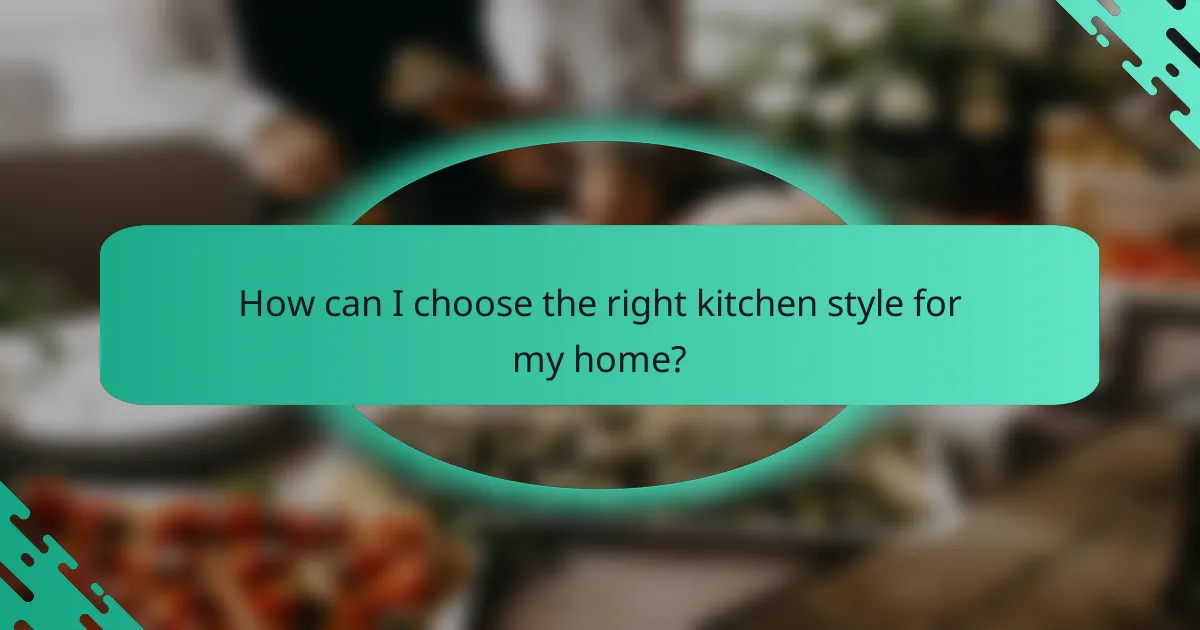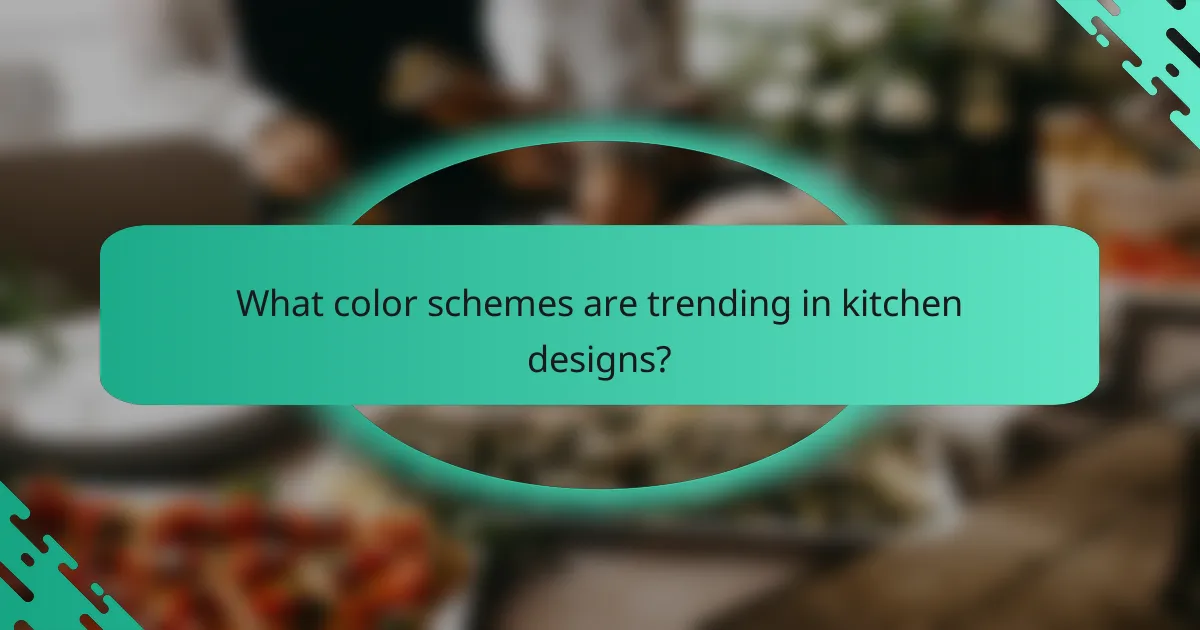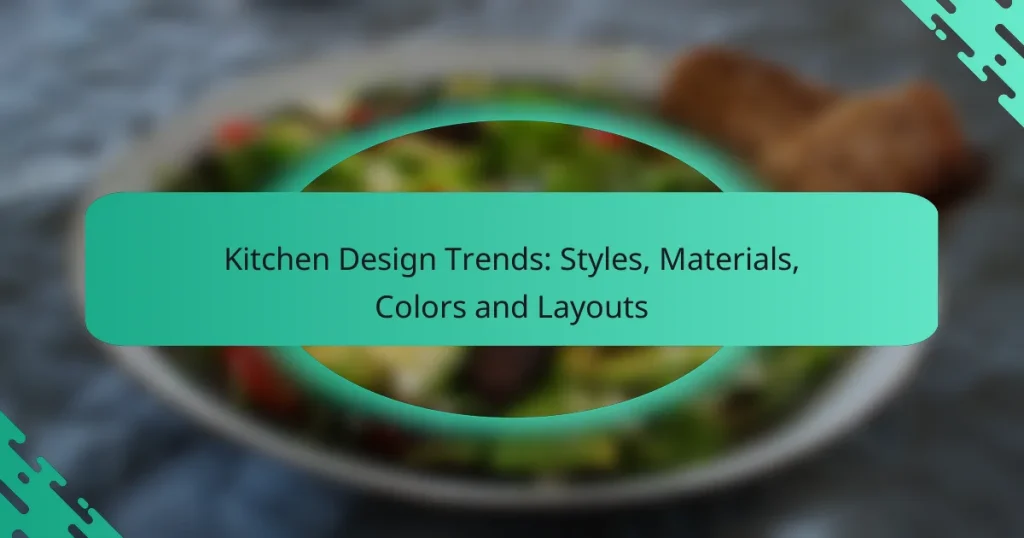As kitchen design continues to evolve, current trends highlight the importance of open layouts, innovative technology, and a harmonious mix of natural and striking elements. Selecting the right style and materials is crucial, as they should reflect both personal taste and practical needs, ensuring the kitchen is both functional and aesthetically pleasing.

What are the latest kitchen design trends in Los Angeles?
The latest kitchen design trends in Los Angeles emphasize open spaces, advanced technology, and a blend of natural and bold elements. Homeowners are increasingly opting for layouts that enhance functionality while reflecting personal style.
Open-concept layouts
Open-concept layouts are a hallmark of modern kitchen design in Los Angeles, promoting a seamless flow between the kitchen, dining, and living areas. This design choice not only maximizes space but also encourages social interaction, making it ideal for entertaining.
When considering an open layout, think about how to integrate storage solutions that maintain a clean aesthetic. Islands or peninsulas can serve as functional focal points, providing additional workspace and seating.
Smart kitchen technology
Smart kitchen technology is becoming increasingly popular, with features like smart refrigerators, ovens, and lighting systems that can be controlled via smartphone apps. These innovations enhance convenience and energy efficiency, allowing homeowners to manage their kitchen remotely.
When incorporating smart technology, focus on devices that offer real value, such as energy monitoring or recipe assistance. Ensure compatibility with existing home automation systems for a cohesive experience.
Minimalist aesthetics
Minimalist aesthetics are trending in Los Angeles kitchens, characterized by clean lines, uncluttered spaces, and a neutral color palette. This design approach emphasizes functionality and simplicity, creating a serene cooking environment.
To achieve a minimalist look, choose cabinetry with flat fronts and avoid excessive ornamentation. Opt for integrated appliances that blend seamlessly into the cabinetry for a streamlined appearance.
Bold color accents
Bold color accents are making a statement in kitchen design, with vibrant hues used strategically to add personality and warmth. Popular choices include deep blues, rich greens, and striking reds, often featured on an accent wall or cabinetry.
When using bold colors, balance them with neutral tones to prevent overwhelming the space. Consider using colorful backsplashes or decorative accessories that can be easily changed as trends evolve.
Natural materials
Natural materials are favored in contemporary kitchens, with wood, stone, and metal being popular choices. These materials not only add warmth and texture but also promote sustainability, aligning with eco-friendly design principles.
Incorporate materials like reclaimed wood for cabinetry or countertops made from sustainable stone. These choices not only enhance aesthetics but also contribute to a healthier indoor environment.

How can I choose the right kitchen style for my home?
Choosing the right kitchen style involves considering your home’s overall aesthetic, your personal preferences, and functional needs. Start by evaluating existing decor, your cooking habits, and how you use the space to find a style that complements your lifestyle.
Modern vs. traditional styles
Modern kitchen styles emphasize clean lines, minimalism, and a functional approach, often featuring materials like stainless steel, glass, and concrete. In contrast, traditional styles focus on warmth and comfort, incorporating wood cabinetry, ornate details, and classic color palettes.
When deciding between modern and traditional, consider the architectural style of your home. A modern kitchen may clash with a historic home, while a traditional kitchen might feel out of place in a contemporary setting. Aim for a cohesive look that enhances your home’s character.
Transitional design elements
Transitional design blends modern and traditional styles, creating a balanced and versatile kitchen space. This approach often features a mix of sleek surfaces and classic details, such as combining contemporary cabinetry with vintage-inspired hardware.
To achieve a successful transitional kitchen, focus on a neutral color palette with pops of color through accessories or appliances. Incorporate both modern materials like quartz countertops and traditional elements like crown molding to create a harmonious environment that feels both timeless and current.

What materials are popular for kitchen countertops?
Popular materials for kitchen countertops include quartz, granite, and recycled options. Each material offers unique benefits and aesthetic qualities, making them suitable for various kitchen designs and budgets.
Quartz surfaces
Quartz surfaces are engineered stone products made from about 90% crushed natural quartz combined with resins and pigments. This material is non-porous, making it resistant to stains and bacteria, which is ideal for kitchen environments.
When choosing quartz, consider the color and pattern options available, as they can mimic natural stones while providing a uniform look. Prices typically range from moderate to high, depending on the brand and design complexity.
Granite options
Granite is a natural stone that offers durability and a unique aesthetic due to its varied patterns and colors. Each slab is distinct, providing a one-of-a-kind look for your kitchen.
While granite is heat and scratch-resistant, it does require periodic sealing to maintain its appearance and prevent staining. Costs for granite countertops can vary widely, often falling in the mid to high range depending on the quality and source.
Recycled materials
Recycled materials, such as glass, paper, and concrete, are becoming increasingly popular for eco-conscious homeowners. These countertops are made from repurposed materials, reducing waste and environmental impact.
When selecting recycled options, look for certifications that ensure sustainability and durability. Prices can vary, but they often fall within a similar range to mid-tier natural stones, making them a practical choice for environmentally friendly designs.

What color schemes are trending in kitchen designs?
Current kitchen design trends highlight a shift towards color schemes that create warmth and sophistication. Popular choices include earthy tones, monochromatic palettes, and contrasting cabinetry, each offering unique aesthetics and functional benefits.
Earthy tones
Earthy tones are gaining popularity for their ability to create a calming and inviting atmosphere in the kitchen. Colors like terracotta, olive green, and warm browns can be paired with natural materials to enhance the organic feel.
When using earthy tones, consider incorporating them through cabinetry, backsplashes, or accent walls. These colors work well with wooden elements and can be complemented by neutral shades for balance.
Monochromatic palettes
Monochromatic palettes focus on varying shades of a single color, creating a cohesive and elegant look. This approach can make a kitchen feel more spacious and streamlined, especially when using light colors like whites or soft grays.
To implement a monochromatic scheme, choose a base color and incorporate different tones through cabinetry, countertops, and accessories. This technique allows for easy integration of textures and materials, enhancing visual interest without overwhelming the space.
Contrasting cabinetry
Contrasting cabinetry involves pairing different colors or finishes for upper and lower cabinets, creating a striking visual effect. This trend allows homeowners to express their style while adding depth to the kitchen design.
For example, pairing dark lower cabinets with light upper cabinets can create a dramatic contrast that draws the eye. When choosing contrasting colors, ensure they complement each other and fit within the overall color scheme of the kitchen.

How can I optimize my kitchen layout?
To optimize your kitchen layout, focus on creating an efficient workflow that minimizes unnecessary movement. Consider the placement of key areas such as cooking, cleaning, and food storage to enhance functionality and accessibility.
Work triangle principles
The work triangle is a design concept that emphasizes the relationship between the three main work areas in the kitchen: the stove, sink, and refrigerator. Ideally, these elements should form a triangle with each side measuring between 4 to 9 feet to ensure efficiency.
When designing your kitchen, ensure that the paths between these points are unobstructed. This layout allows for smooth transitions while cooking, reducing the time spent walking back and forth. Avoid placing any obstacles, such as cabinets or islands, within this triangular space.
Zone-based layouts
Zone-based layouts organize the kitchen into specific areas for distinct tasks, such as cooking, prep, and cleaning. This approach allows for better workflow and can be tailored to your cooking habits and family needs.
For example, consider grouping cooking utensils and pots near the stove, while placing cutting boards and knives close to the prep area. This minimizes movement and makes it easier to access everything you need. When planning your zones, think about how often you use each area and adjust accordingly.

What are the key considerations for kitchen lighting?
Key considerations for kitchen lighting include functionality, ambiance, and energy efficiency. A well-lit kitchen enhances usability and creates a welcoming atmosphere while also being mindful of energy consumption.
Layered lighting techniques
Layered lighting involves combining different types of lighting to achieve a balanced and versatile illumination. This typically includes ambient lighting for overall brightness, task lighting for specific work areas, and accent lighting to highlight design features.
For example, use overhead fixtures or recessed lights for ambient light, under-cabinet lights for task lighting, and pendant lights or spotlights to accentuate artwork or architectural details. This approach allows you to adjust the lighting based on the time of day or activity.
Energy-efficient options
Energy-efficient lighting options can significantly reduce electricity bills while providing adequate illumination. LED bulbs are a popular choice, consuming up to 80% less energy than traditional incandescent bulbs and lasting much longer.
When selecting fixtures, look for those with the ENERGY STAR label, which indicates they meet strict efficiency guidelines. Additionally, consider incorporating dimmers or smart lighting systems to further enhance energy savings and control over your kitchen’s lighting environment.

How do I incorporate sustainable practices in kitchen design?
Incorporating sustainable practices in kitchen design involves using eco-friendly materials, energy-efficient appliances, and waste-reducing layouts. Focus on sourcing local products and minimizing environmental impact throughout the kitchen’s lifecycle.
Choose eco-friendly materials
Selecting eco-friendly materials is crucial for a sustainable kitchen. Look for options like bamboo, reclaimed wood, or recycled metal, which have a lower environmental footprint. Additionally, consider low-VOC (volatile organic compounds) paints and finishes to improve indoor air quality.
Invest in energy-efficient appliances
Energy-efficient appliances can significantly reduce energy consumption in your kitchen. Look for products with the ENERGY STAR label, which indicates they meet strict efficiency guidelines. These appliances often use up to 50% less energy than standard models, saving you money on utility bills over time.
Implement waste-reducing layouts
Designing a kitchen layout that minimizes waste is essential for sustainability. Incorporate recycling and composting stations to encourage responsible waste disposal. Additionally, consider a layout that promotes efficient workflows, reducing food waste by making meal prep easier and more organized.


